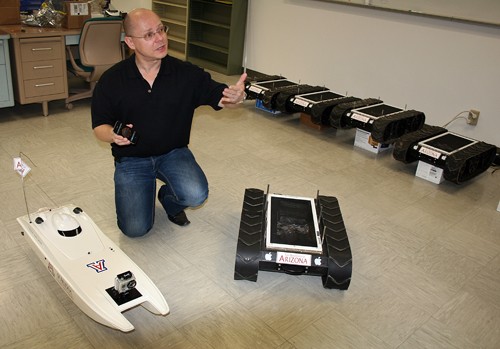UA researchers continue to strive for a time where unmanned robots are capable of operating themselves without human input, and some think the technology could become mainstream soon.
Wolfgang Fink, an Edward and Maria Keonjian Endowed Chair and associate professor of electrical and computer engineering, came to the UA in 2009 to do more work on autonomous rovers, much like those in his favorite example, “”Star Wars: Episode V — The Empire Strikes Back.””
But unlike the 1980 film, Fink’s rovers aren’t fiction. They hold 60 pounds and can be used to explore Earth, Mars and the lakes of Titan, Saturn’s largest moon.
“”The whole point is not to have human interaction,”” Fink said.
Fink’s research group was the first to develop the reconnaissance system, a three-tiered information flow route that allows overhead orbiting satellites to help surface-level rovers maneuver during exploration. The system shortens communication time between operator and explorer from two or three days to two or three hours.
“”Yesterday, we were at the mercy of the ground controller,”” Fink said. “”Today we are one step down from where the space craft can direct its own course.””
The rovers operate on Mac mini computers and are controlled by iOS electronics technology, which is similar to the iPod Touch or iPhone.
Jonathan Sprinkle, assistant professor of electrical and computer engineering, said that finding out how robots “”behave themselves”” when given autonomy is the next step.
“”There are a lot of schools that are doing something with autonomy … but the UA is uniquely and opportunistically placed within that,”” Sprinkle said. “”The UA has got the science knowledge and the engineering knowledge. It makes it much easier for the UA to have a really big impact.””
Sprinkle said he could see this kind of technology trickling down to the mainstream, from drones that can stay airborne indefinitely to being able to operate a home thermostat via a smart phone.
“”And it’s making its way into the classroom,”” Sprinkle said. “”More and more we’d like to have students say, ‘I can program an iPhone to operate that robot.'””
The rover technology could also have uses outside of the classroom, such as robotic mine rescue, according to Sean Dessureault, associate professor of mining and geological engineering.
Dessureault is utilizing Fink’s contribution to re-establish high-bandwidth wireless communications underground, where it’s unsafe for people to venture. Instead of being operated via iPhone, sensor-triggered robot coordination between various rovers would help establish the communication.
“”You want to push as much intelligence on the machine as possible,”” he said. “”But it requires sufficiently sophisticated control to go from research into industrial practice.””
Dessureault said it could be a couple of months before government agency funds for mine rovers would be assured. Fink hopes to have a working model of a boat-style rover by the end of the semester and an expansion on the developed indoor version by the end of 2011.









